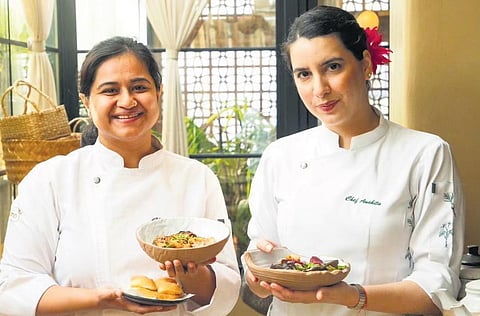

When it comes to the kitchens of our home, we always associate them with our mothers and grandmothers. Their space inside the four walls of the home has been romanticized to no end since time immemorial. “Maa ke haath ka khaana” is an emotion; and no, I am not saying that it isn’t, but one must also take into account how we have tied the women and their identities down to these four walls. Some women take to cooking naturally, and some have no option but to, because of the expectations of society.
Funnily, when it comes to commercial kitchens, it continue to be a male-dominated sphere even after all this time. The fact is that a commercial kitchen is treated like a ‘job’, as compared to the not-so-glamorous home kitchens. But slowly, if not steadily, one can notice a revolution in this space, where women are not just taking on executive roles in commercial kitchens, but also leading and redefining the manner in which we look at Indian home-style food.
Over the last two weeks, I got to taste some exquisite dishes by three such chefs in two of India’s biggest metro cities. Food that takes from their childhood memories and community food, but is also fit for a fine-dining space.
Mumbai’s 126-year-old heritage building Kitab Mahal houses Ekaa, an ingredient-forward restaurant by chef Niyati Rao and her partner. Already in the list of Asia’s 50 Best restaurants, the food philosophy here is to play with nostalgia through hyper-local and sustainably sourced ingredients. On entering Ekaa, you feel like you have entered a theatre - a live theatre of food. With the open kitchen being backstage, one can get a peek into the actors’ (chefs) preparation for their performance, which translates into the plates of the diners.
“Sit back and enjoy the show,” Chef Rao tells me before vanishing in the kitchen, validating my observation of the place. This was my first time trying her food, which is right now the talk of the country. We are soon served two cones with some froth on a platter. I am intrigued. The menu suggests that it is a “pickle sandwich” - not something I’ve ever heard of before. Chef Rao appears and explains that it is her take on the sandwich that her mother used to make for her as an after-school snack, originally consisting of bread, pickled cucumbers, peanut butter, and cheese.
At Ekaa, she has turned this into modern art - something that might seem odd, but once consumed, you begin to understand its nuances. The odd-sounding dish was the highlight of my meal, to be honest. A croustade with pickled cucumber, peanut brittle, and topped with cheese foam - talk about food alchemy!
Back in Delhi, chef Vanshika Bhatia and chef Anahita Dhondy have come together to launch the concept of ‘OMO Tables’ at Cafe OMO in Gurugram. Here, Chef Dhondy brings to the fore her Parsi culinary heritage on a platter, but in OMO style i.e. vegetarian and sustainably sourced. First of all, vegetarian Parsi food in itself is an oxymoron, but for Dhondy to take up this challenge and then deliver on it, is no mean feat.
I tasted all that was on offer in this collaborative menu, but what stood out for me was the topli paneer, served on a bed of beetroot puree that has been seasoned with EF Kolah vinegar- very intrinsic to the Parsi community. The quintessential berry pulao was served with red rice, zereshk berries, and winter greens, which was a take on the Parsi ‘bhaji dana’. The highlight of this meal though was the little millet pudding, which was a take on the classic ‘ravo’ - a dish that is part of every Parsi celebration, but served here with millet. A porridge-like pudding, with mild sweetness and lots of dried fruits, was the perfect hug in a cup in the Delhi winters.
Chefs (yes, chefs, and not “female chefs”) like Rao, Dhondy, and Bhatia are not just young guns out to claim their place in the culinary world but are forced to reckon with. These women come with the advantage of their mothers’ and grandmothers’ culinary wisdom, their drive to put their community’s culinary heritage on the map, and all the while showcasing their incredible experiences as chefs - in the home kitchens and commercial kitchens. Women, like always, are the culinary chroniclers who will ensure that our culinary heritage thrives.